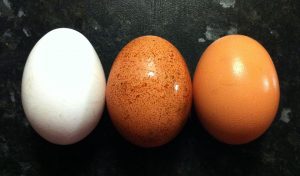Egg shell colour is mainly determined by genetics. The effect of strong sun and high temperatures on hens can produce a fading effect on the shells. Why too much sun affects the surface pigmentation in this way is unknown. It can be a problem for those who sell such eggs.
– by Katie Thear
 The Maran, Welsummer and Speckledy breeds normally lay dark brown, speckled eggs but sometimes the hens will lay light coloured eggs.. One way of dealing with the problem is to confine the chickens for a few days. This may be difficult for those who are selling eggs described as free-range, where the chickens are supposed to have unrestricted access to the outside during the day.
The Maran, Welsummer and Speckledy breeds normally lay dark brown, speckled eggs but sometimes the hens will lay light coloured eggs.. One way of dealing with the problem is to confine the chickens for a few days. This may be difficult for those who are selling eggs described as free-range, where the chickens are supposed to have unrestricted access to the outside during the day.
Pale Egg Problem in Tropical Countries, Australia & New Zealand
Pale egg shell colour is much better known in hot countries than it is in our northern climes, for obvious reasons. It has really only emerged as a topic for discussion in Britain since free-range management made a return to the commercial sector.
Traditional knowledge, as for example in my parents’ generation, has always recognised it, hence their emphasis on the importance of extra shade and cold water to drink in the summer. Their knowledge was based on experience rather than on experimental research, but the subject has attracted the attention of scientists in recent years.
Research in Australia has shown that providing water at a temperature of 5°C in very hot weather enabled hens to produce eggs that maintained their dark shell colour. The shells also had a better weight and shell breaking strength. (Ref: Shell Quality and Cooling Drinking Water. Tangkere, Bhandra & Dingle. University of Queensland. 2001).
Stress Can Effect Egg Colour
There are also other reasons why shell colour becomes paler. Stress, for example, can affect the colour intensity. A sudden disturbance to the normal routine may result in a hen retaining the egg within the shell gland area of the oviduct for a longer than normal period.
During this time a very thin layer of extra calcium is deposited on the egg, producing a greyish, bleached out look. By the same token, an egg that is laid prematurely may not have had enough pigment deposited. Stress can be caused by many different factors. These include sudden changes to routine, moving to another environment, change to the diet and shocks such as loud noises, bullying within the flock or the presence of predators.
Diet – Availability of Minerals & Vitamins
Diet is important in producing quality eggs. There needs to be a well-balanced ration that provides the whole range of nutrients, vitamins and minerals. For free-range layers this is the provision of a proprietary compound feed used in association with grass paddocks.
We already know that grass and other plants such as clovers and lucerne enhance the yellow colour of the yolk. What is also likely is that they also contribute to the vibrancy of shell colour. A good quality organic or free-range feed is essential, while the grass should be clean, short and with plenty of new growth tillers (tips).
Coccidiostat Affects Egg Shell Colour
The presence of the coccidiostat Nicarbazin in the feed can produce paler shells. Again, make sure that only good quality organic or free-range feeds without this additive. The ingredients should be clearly listed on the label, so do check.
Illness, Age and Parasites
Viral infections can lead to loss of shell colour, as well as egg deformities and a reduction in egg numbers. They include Infectious bronchitis, Newcastle disease and Egg drop syndrome.
Older hens are more likely to produce paler eggshells than younger birds. Replacements will need to be made available on a regular basis if egg quality is to be maintained.
The presence of parasitic red mites that emerge at night to feed on the perching hens can have a debilitating effect on the birds, leading to anaemia and the loss of egg colour. Check the house and birds regularly. There are several proprietary products available for dealing with red mites.
Finally, the presence of parasitic worms can debilitate the chickens to the extent that their nutritional intake is affected. This, in turn, leads to the production of pale eggs. A wormer such as Flubenvet added to the feed is effective in getting rid of internal parasites. After treatment the birds should go out onto clean pasture that has not been used by poultry in the same season.
Further Articles All About Eggs
- Araucana Egg Shell Colour & Genetics
- Build Your Own Artificial Lighting System for Winter Egg Production
- Changing Egg Yolk Colour with Feeding
- Double Yolk Eggs – What Causes Double Yolk Eggs?
- Egg Shell Colour Chart by Breed of Hen
- Egg Structure – The Structure of an Egg
- Eggs from Different Species
- Know Your Eggs? – Egg Descriptions Explained
- Marketing Your Surplus Eggs – How to Sell Your Eggs
- Nutritional Value of Eggs – Are Free Range Eggs Better for You?
- Pale Eggs – Egg Shell Colour
- Problems With Eggs – Yolks & Whites
- Saving Money – Economics of Home Produced Eggs
- Selling Your Surplus Eggs at Markets
- Selling Your Surplus Eggs from Home – Farm Gate Egg Sales
- Thin Eggshells – Causes & Cures
- What to do with Surplus Eggs? How to Store Eggs

